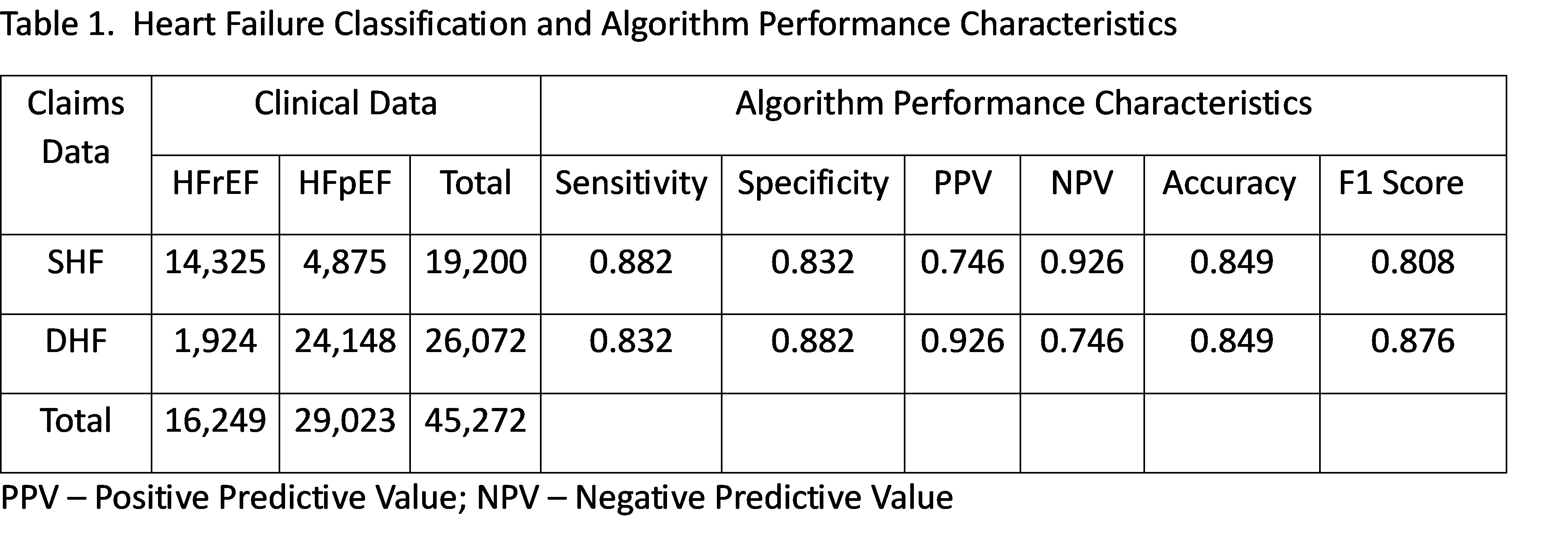Final ID: Su3061
Validation of ICD-10-CM diagnosis codes for heart failure classification within an integrated US administrative claims and electronic medical record (EMR) database
Abstract Body (Do not enter title and authors here): Objective: Identification of individuals with reduced or preserved ejection fraction heart failure (HFrEF/HFpEF) within claims data is typically based on ICD-10-CM diagnosis codes that use systolic and diastolic HF (SHF/DHF) nomenclature. The objective of this study was to assess the performance characteristics of using ICD-10-CM diagnostic codes from claims data for HFrEF and HFpEF classification relative to a reference standard using EF results or clinician documentation within an integrated claims/EMR database.
Methods: EMR data from the Healthcare Integrated Research Database (HIRD®) were searched to identify patients with EF assessment between 01/01/2016 and 01/31/2023. HFrEF was defined as EF ≤ 40% or documented reduced EF, while HFpEF was defined as EF ≥ 50% or documented preserved/normal EF. The most recent EF assessment date or EMR entry date (if EF assessment date not available) was set as the index date. Claims submitted from 7 days to 6 months post index date were then reviewed to identify SHF and DHF diagnoses as well as comorbid conditions. Analyses were performed to determine sensitivity, specificity, and positive/negative predictive values (PPV/NPV), accuracy and F1 scores of the claims-based algorithm, with a sensitivity analysis performed using the subset of patients with a known EF assessment date available.
Results: A total of 45,272 patients had EF assessment in the EMR data with either a SHF or DHF diagnoses in the claims data. Mean (SD) age was 71.7 (12.7) years, 51.2% were male. The most common comorbidities of interest included hypertension (89.5%), dyslipidemia (71.9%), atrial fibrillation (45.9%), type 2 diabetes (43.7%), and chronic kidney disease (39.6%). Counts by heart failure classification and algorithm performance characteristics are in Table 1. Sensitivity analyses for those with known EF assessment dates showed similar results.
Conclusions: Overall performance of the claims-based algorithm was good to very good, although EF data integrated with claims data can improve HF classification. Future claims-based algorithm development could also incorporate treatments and comorbidities to improve performance.
Methods: EMR data from the Healthcare Integrated Research Database (HIRD®) were searched to identify patients with EF assessment between 01/01/2016 and 01/31/2023. HFrEF was defined as EF ≤ 40% or documented reduced EF, while HFpEF was defined as EF ≥ 50% or documented preserved/normal EF. The most recent EF assessment date or EMR entry date (if EF assessment date not available) was set as the index date. Claims submitted from 7 days to 6 months post index date were then reviewed to identify SHF and DHF diagnoses as well as comorbid conditions. Analyses were performed to determine sensitivity, specificity, and positive/negative predictive values (PPV/NPV), accuracy and F1 scores of the claims-based algorithm, with a sensitivity analysis performed using the subset of patients with a known EF assessment date available.
Results: A total of 45,272 patients had EF assessment in the EMR data with either a SHF or DHF diagnoses in the claims data. Mean (SD) age was 71.7 (12.7) years, 51.2% were male. The most common comorbidities of interest included hypertension (89.5%), dyslipidemia (71.9%), atrial fibrillation (45.9%), type 2 diabetes (43.7%), and chronic kidney disease (39.6%). Counts by heart failure classification and algorithm performance characteristics are in Table 1. Sensitivity analyses for those with known EF assessment dates showed similar results.
Conclusions: Overall performance of the claims-based algorithm was good to very good, although EF data integrated with claims data can improve HF classification. Future claims-based algorithm development could also incorporate treatments and comorbidities to improve performance.
More abstracts on this topic:
Assessing the Impact of a Healthy Foods Center Program Has on Food Insecurity and Healthcare Outcomes: A Pilot Study
Drury-gworek Charlotte, Galper Kathleen, Barrett Tyson, Shergill Amber, Cuevas Elizabeth, Ereditario Colleen
Combination Glucagon-Like Peptide-1 Receptor Agonist and Sodium-Glucose Cotransporter-2 Inhibitor Therapy Reduces Admissions and Death in Patients with Heart Failure with Reduced Ejection FractionMensah Samuel, Kwaah Patrick, Kwakye Ama Owusuaa, Balla Sudarshan, Patel Brijesh

